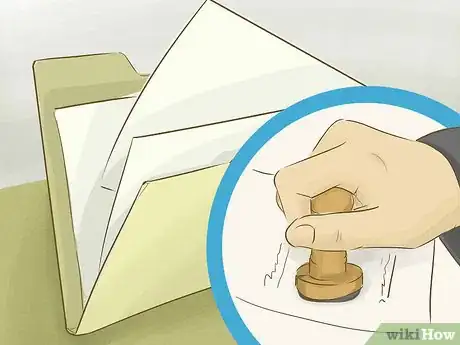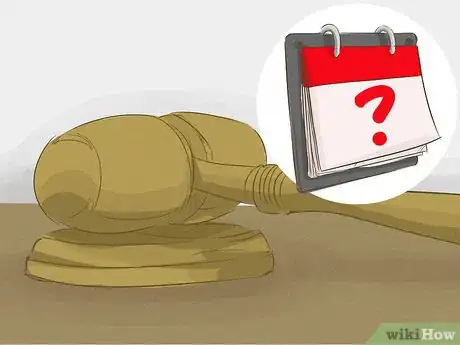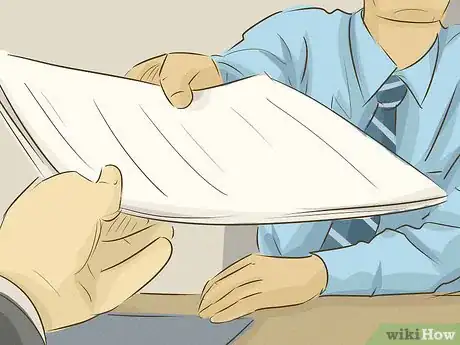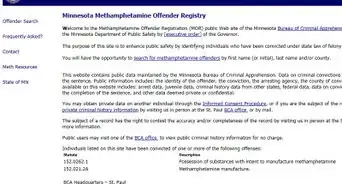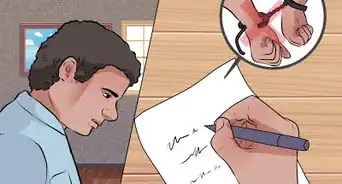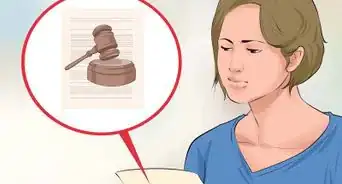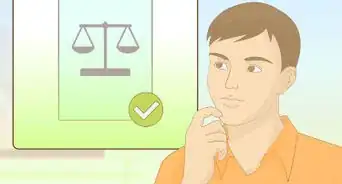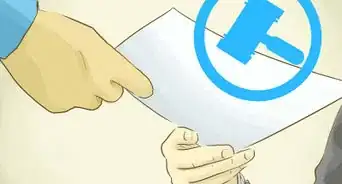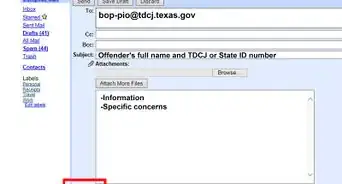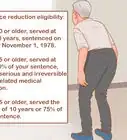This article was co-authored by Clinton M. Sandvick, JD, PhD. Clinton M. Sandvick worked as a civil litigator in California for over 7 years. He received his JD from the University of Wisconsin-Madison in 1998 and his PhD in American History from the University of Oregon in 2013.
There are 7 references cited in this article, which can be found at the bottom of the page.
This article has been viewed 35,078 times.
Probation is imposed on a person in lieu of a jail sentence. The length of probation will depend on the offense committed. Generally, probation can last from one to three years but can be longer for serious offenses like drug or sex offenses.[1] To shorten the probationary period, a person will need to petition a court and explain why shortening the probation is warranted. Before doing so, you need to satisfy your state’s legal requirements and the conditions of your probation.
Steps
Understanding Probation
-
1Find your state law. If your state allows probation to be shortened, then there should be a law to that effect. You will want to see what requirements are listed in the law. For example, some states will only allow probation to be shortened for certain crimes but not others. In Texas, for instance, you cannot shorten probation if you were convicted of a sex offense or of driving while intoxicated.
- Type “your state” and “probation” into your favorite web browser. Look for state websites, which will probably host the text of your state statutes.
-
2Read the terms of your probation. You need to understand precisely what you were ordered to do during your probationary period. Accordingly, you should get a copy of the court order. Check to see what conditions you have already satisfied and which ones remain to be completed.
- If you do not have your copy, then ask your probation officer for a copy. He or she should have it.[2]
Advertisement -
3Meet with an attorney. To fully understand your state’s laws and to get advice on how to apply to shorten your probation, you should consider meeting with an attorney. An experienced criminal defense lawyer will listen to the facts of your case and make recommendations. The lawyer could also help you file the motion in court and appear with you before the judge.
- To find an experienced criminal defense attorney, you can visit your state’s bar association, which should run a referral service. You also should see Choose a Criminal Defense Lawyer for tips.
- You might want to hire an attorney to offer limited assistance. Even if costs are a concern, you should realize that in most states attorneys can now offer “unbundled” legal services. This means that the attorney agrees to perform discrete tasks rather than take over the entire representation. This type of “limited scope representation” can be an effective way of keeping legal costs down.
Satisfying the Conditions of Probation
-
1Complete a certain percentage of your probation. Some state laws require that you have completed a certain percentage of your probation before you can petition the court to shorten it. In Wisconsin, for example, you must complete at least 50% of your probation.[3]
- Accordingly, if you were ordered to serve three years of probation but only one year has passed, then you do not qualify.
-
2Complete the conditions of your probation. You may have had many conditions imposed on you as part of probation. For example, you might have been ordered to pay restitution to the victim of your crime. Or the judge may have ordered that you perform a certain number of hours of community service.[4] You will need to make sure that you have completed the conditions, as a judge is unlikely to shorten your probation if you have not.
-
3Gather evidence that you have completed the conditions. You should always be prepared to show that you have, in fact, completed all necessary conditions. If you were required to take a class, then hold onto your certificate of completion.
- If you had to pay restitution, then produce your cancelled checks or the receipt you might have received from the court (if you paid the restitution into a court).
-
4Discuss shortening probation with your probation officer. You should be upfront and tell your probation officer that you want to shorten the length of your probation. Ask the officer for advice on what you can do to make a strong case for yourself. Follow any advice given.
- Your probation officer will be allowed to testify at the hearing about whether or not you deserve to have your probation terminated or modified. Accordingly, it is in your best interest to follow his or her advice and to address any weaknesses before petitioning the court to shorten your probation.
Petitioning the Court
-
1Get a form petition. Some courts might have printed “fill in the blank” forms for you to use. You should ask the clerk of the court where you were sentenced whether such a form is available.
- Colorado, for example, has a printed “Request to Terminate or Modify Probation or Deferred Sentence” form, which is available at https://www.courts.state.co.us/userfiles/file/Court_Probation/20th_Judicial_District/Court%20Business%20Resorces/RequesttoTermProb%206-11-13.pdf.
-
2Draft your own petition. If no form is available, then you will need to draft your own petition/motion. Your attorney can draft it for you (if you have hired an attorney). If you need to draft it on your own, then follow these steps:
- Try to find a sample motion for your state. Create a search string in your favorite web browser consisting of “your state,” “sample motion” and either “terminate probation” or “modify probation.” Then look to see if there are any sample motions that you can use as models.
- When typing up your motion, you will include the header information at the top. You can pull the header information from an old motion in your criminal case. The header includes the names of the parties, the case number, and the name of the judge.
- Below the header, insert the title in all caps, bolded. Look to see what title the sample uses. If you don’t have a sample to use as a guide, then title it “Motion to Terminate Probation” or “Motion to Modify Probation.”
- In the first paragraph, identify yourself and if you are representing yourself (“pro se”). You can type, “Comes now the Defendant, pro se, [insert your name], and moves this Honorable Court to modify his probation. In support of this motion, Defendant states:”
- Then, list the facts in numbered format:
- The date you were placed on probation. “Defendant was placed on probation on [insert date].”
- The length of probation. “The period of supervision was for X months/years.”
- That you committed no violations. “During the period of supervision, there has been no violation papers filed.”
- That all conditions have been met. “All conditions of the supervision have been completed.”
- Whether your probation officer objects. You should have found this out when you last met with him or her. “The probation officer does not object to an early termination/modification.”
- The name of your probation officer.
- Add a conclusion. You can type, “WHEREFORE, Defendant respectfully requests that this Honorable Court grant this Motion and issue an Order modifying/terminating probation in this case.”
-
3Have the petition notarized. You should probably have the petition notarized. Accordingly, hold off on signing the motion until you appear before the notary public. Search the internet for notary blocks applicable to your state. Insert the block a couple lines beneath the conclusion of your motion.
- You can find a notary public in most large banks as well as in the courthouse.
-
4File the petition. Make several copies of your motion and take them all to the courthouse. Tell the court clerk that you want to file the original. Have the clerk date stamp all of your copies.
- You will probably have to pay a filing fee, which varies by court. If you cannot afford the filing fee, then ask the court clerk for a fee waiver form and fill it out.
-
5Get a court date. You may have to pick up a court date when you file your petition. If so, then you may have to fill out a Notice of Hearing form on which you will write the date and time of the hearing. Ask the court clerk if you need to do this.
- Alternately, some courts might mail you the court hearing at a later date and notify all of the parties.
-
6Serve notice. You will probably need to send copies of your motion (and the Notice of Hearing, if applicable) to the district attorney and the probation department. You shouldn’t wait to serve notice but should instead schedule it as soon as possible after you file. Ask the court clerk what are acceptable methods of service.
- You can typically have the sheriff, a private process server, or someone over the age of 18 serve the papers in person. You will have to pay a fee if you use the sheriff or a process server. Process servers generally cost $45-75; sheriffs usually cost a little less.[7] [8] You cannot serve the papers yourself.
- The person who makes personal service also must fill out proof that they made service. This is usually called a “Proof of Service” form or an “Affidavit of Service.” Ask the court clerk for the form and give it to the server.
- Once the signed Proof of Service is returned to you, you should file it as soon as possible with the court.
Attending the Hearing
-
1Prepare for the hearing. You can prepare by reviewing your petition. Also gather any relevant paperwork to take with you.
- If you have a lawyer, then you should discuss what kinds of questions the judge may ask you. It is your task at the hearing to convince the judge that your good conduct justifies termination of probation. You must also show that you have reformed yourself.[9]
- Your attorney might have ideas about what kind of evidence you could present to support your motion. For example, you might get a character reference letter from an employer, pastor, or other person who knows you.
-
2Arrive early. You should give yourself plenty of time to find parking and to go through any security at the courthouse. You should aim to be in the appropriate courtroom at least 15 minutes before the hearing is supposed to start.
- If you need something to eat or drink before the hearing, then consume all food and drinks before entering the courthouse.
-
3Dress appropriately. You should strive to look clean and neat at the court hearing. Although you don’t have to wear a suit, men should wear long pants (not shorts) with a collared shirt (tucked in). Also try to wear a tie. Make sure you are wearing socks with your shoes.
- Women should wear a dress, skirt, or long pants with a blouse or sweater.
- In no circumstances should you wear shorts, hats, halter or see-through tops, flip-flops, belly shirts, torn jeans, or low-hanging pants. Also avoid clothing that has offensive language or imagery on it.
-
4Present your case. You have the burden of convincing the judge that shortening your probation is warranted. Accordingly, you will go first. You might repeat what was in your motion or the judge could ask you only to raise new points not in the motion.
- The judge may also have questions for you. You should answer all questions honestly and respectfully. Make sure to address the judge as “Your Honor” or “Judge [last name].”
-
5Listen to the prosecutor. The prosecutor will also speak at the hearing. Generally, he or she will state the reasons for supporting or objecting to shortening your probation.
- Your probation officer may also attend the hearing and offer an opinion to the judge about whether or not you should be granted early termination of your probation. If the officer doesn’t show up, the judge may want to continue the hearing until the officer can attend. Judges tend to place great weight on the probation officer’s opinion.
-
6Draft the order. Sometimes the judge will have a clerk draft the order. In other courts, however, the party who prevails often is tasked with writing up the order. There should be blank forms in the courtroom for you to use.
- You can write, “It is hereby ordered that the probation imposed on the above-named defendant on [insert the conviction date] is hereby terminated.”
-
7Apply again, if necessary. If you do not prevail at the hearing, then the judge should inform you of when you may apply again. If not, then be sure to ask.
- You also might be able to appeal. To determine whether or not an appeal would be worthwhile, you should check with a lawyer.
References
- ↑ http://criminal.findlaw.com/criminal-procedure/probation-faq.html
- ↑ http://doc.wi.gov/community-resources/faq
- ↑ http://doc.wi.gov/community-resources/faq
- ↑ http://doc.wi.gov/community-resources/faq
- ↑ http://michigancriminalattorney.com/probation-early-defend-probation-violation/
- ↑ http://michigancriminalattorney.com/probation-early-defend-probation-violation/
- ↑ http://www.serve-now.com/about-process-serving
- ↑ http://www.serve-now.com/articles/841/process-server-vs-sheriff-infographic
- ↑ http://www.shouselaw.com/early-probation-termination.html









